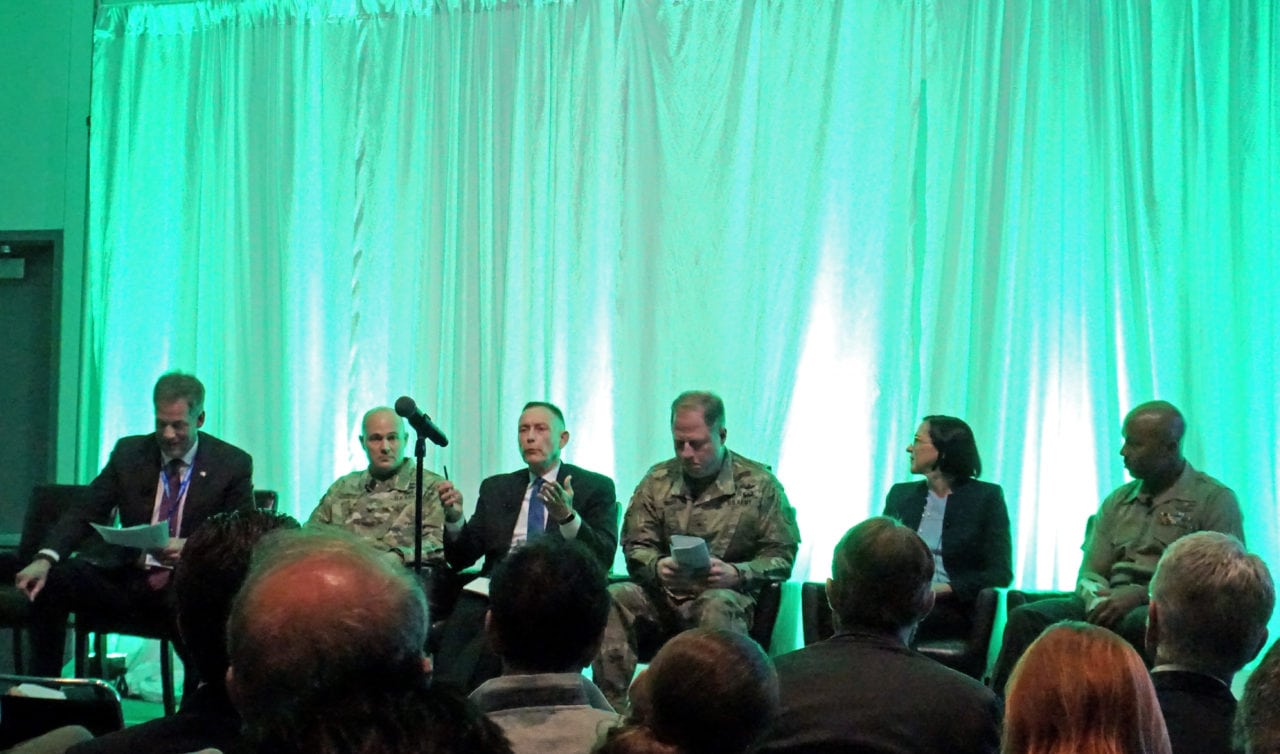
Officials gathered at AUVSI Xponential in Denver to discuss the future of UAS in the military.
Senior officials from across the U.S. military were gathered in Denver for AUVSI Xponential this week to discuss with industry what the U.S. Defense Department (DOD) wants to get out of drones in the future.
The answer? You tell them.
“I don’t think we should tell you where to invest,” said Col. Ché Bolden, assistant chief of staff for the U.S. Marine Corps Installations Command. “You should tell us where to do it. If we say ‘hey, we want this thing,’ and you know it makes no sense, tell us it makes no sense. Tell us where to go next.”
Brig. Gen Walter Rugen, who directs the U.S. Army-led Future Vertical Lift team, echoed Bolden’s sentiment.
“The UAS industry is innovative. You guys know best,” he said. “Tell us where to (invest). We’ve wasted money in the past.”
Rugen said that the DOD is looking to be more agile in its procurements and that contract-writing will enable that.
“We want to write contract vehicles now that facilitate. Get away from (Department of Defense Instruction) 5000.2 that bottlenecked you into a defined, process-driven space … and write so you can innovate. Our senior leaders are all in on that.”
Deputy Assistant Secretary of the Navy Frank Kelley said that the DOD wants to prevent the repeat of miscommunications that have occurred in the past.
“We should have done a better job in the past expressing to the industry what we’re thinking,” he said. “Sometimes, also, industry has good ideas and is reluctant to come forward. So, come forward. Tell us. Tell us where you’re investing.”
All that is not to say that the military doesn’t have ideas of its own about what it wants.

The AeroVironment Wasp, a small UAS developed for military use. (File photo)
Col. Courtney Cote, the UAS Project Office’s project manager for the Army, sees UAS as being able to take the place of soldiers in dangerous situations, like entering a breach.
“If the first person through the breach is a human we have failed,” Cote said. “We have failed to employ autonomous machines in land, air, sea or any other domain.”
Rugen summed up the benefit of autonomy as taking over the “dull, dirty and dangerous” work, such as 24-hour surveillance, working in radioactive areas and high-risk work, respectively. He also noted that there doesn’t need to be a binary choice between autonomous and manned; offloading cockpit tasks to autonomous systems to allow the pilot to “focus on other stuff and bring that lethality is still huge even if it isn’t totally autonomous.”
In terms of specifics, Rugen said that the Army was worryingly runway-dependent right now and wanted to be as independent of them as possible soon. He also said the Army needed more power in unmanned systems for capabilities such as electronic warfare and stressed the importance of munitions cost.
“When we’re shooting Hellfires and JAG missiles at things that aren’t tanks, those things are just cha-ching, cha-ching,” he said. “Help us with the price point on lethality.”
Rugen’s final note was that unmanned systems “can’t have a big tail,” meaning too many people required to operate them. “Army unmanned systems are pretty intensively manned,” he said.
Kelley talked about the importance of modeling and simulation work for planning out the future of manned-unmanned cooperation and for placing theory into practice. “Is it better for an unmanned underwater vehicle to be able to stay there for 30 extra days or is speed more important? How important is it to communicate 24/7?” Try it and find out.
He went farther and said that he sees the gaming industry as holding remarkable potential because of the unmatched way it combines competition, communication and the need to figure out tactics, letting users test things within the world.
“I’m always amazed when I watch my college kids come home and play Fortnite, and it is incredible how these kids engage in an intense, competitive, combative environment,” Kelley said.
Bolden said there are a lot of areas that unmanned can help the Marines, but the top one is easy: awareness.
He referenced a Secretary of Defense James Mattis quote that “the enemy always gets a vote,” but added that “if you know how he’s going to vote, his vote doesn’t matter.”
Bolden also said that UAS can provide the Marines a notable strategic advantage in using that awareness and their range to penetrate integrated air defense systems like China’s.
“That’s one advantage unmanned systems can give us: persistence, reach, range you can’t match with a manned platform,” he said. “We can send the system out there to just go around them. Good on the Chinese if they can defend that entire country. I doubt that they can.”